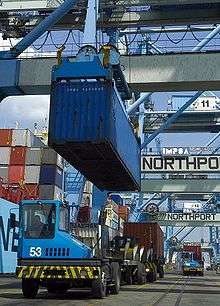Special economic zone
A special economic zone (SEZ) is an area in which business and trade laws differ from the rest of the country. SEZs are located within a country's national borders, and their aims include: increased trade, increased investment, job creation and effective administration. To encourage businesses to set up in the zone, financial policies are introduced. These policies typically regard investing, taxation, trading, quotas, customs and labour regulations. Additionally, companies may be offered tax holidays, where upon establishing in a zone they are granted a period of lower taxation.
The creation of special economic zones by the host country may be motivated by the desire to attract foreign direct investment (FDI).[1][2] The benefits a company gains by being in a special economic zone may mean it can produce and trade goods at a lower price, aimed at being globally competitive.[1][3] In some countries the zones have been criticized for being little more than Chinese labor camps, with workers denied fundamental labor rights.[4][5]
Definition
The operating definition of a SEZ is determined individually by each country. According to the World Bank in 2008, the modern day special economic zone typically includes a "geographically delimited area, usually physically secured (fenced-in); single management/administration; eligibility for benefits based upon physical location within the zone; separate customs area (duty-free benefits) and streamlined procedures."[6]
History
Free zones and Entrepôts have been used for centuries to guarantee free storage and exchange along trade routes.
Modern SEZs appeared from late 1950s in industrial countries. The first was in Shannon Airport in Clare, Ireland.[7] From the 1970s onward, zones providing labor-intensive manufacturing have been established, starting in Latin America and East Asia. The first in China following the opening of China in 1979 by Deng Xiaoping was the Shenzhen Special Economic Zone, which encouraged foreign investment and simultaneously accelerated industrialization in this region. These zones attracted investment from multinational corporations.[1]
A recent trend has been for African countries to set up SEZs in partnership with China.[2]
Types
The term special economic zone can include:[1][8]
- Free trade zones (FTZ)
- Export processing zones (EPZ)
- Free zones/ Free economic zones (FZ/ FEZ)
- Industrial parks/ industrial estates (IE)
- Free ports
- Bonded logistics parks (BLP
- Urban enterprise zones
The World Bank created the following table to clarify distinctions between types of special economic zones:
| Type [6] | Objective | Size | Typical Location | Typical Activities | Markets |
|---|---|---|---|---|---|
| FTZ | Support trade | <50 hectares | Port of entry | Entrepôts and trade related | Domestic, re-export |
| EPZ (traditional) | Export manufacturing | <100 hectares | None | Manufacturing, processing | Mostly export |
| EPZ (single Unit/free enterprise) | Export manufacturing | No minimum | Countrywide | Manufacturing, processing | Mostly export |
| EPZ (hybrid) | Export manufacturing | <100 hectares | None | Manufacturing, processing | Export, domestic |
| Free port/SEZ | Integrated development | >1000 hectares | None | Multi-use | Internal, domestic, export |
| Urban enterprise zone | Urban revitalization | <50 hectares | Urban/rural | Multi-use | Domestic |
Special economic zones by country
UNIDO Viet Nam (United Nations Industrial Development Organization) has compiled a list in 2015 of Special Economic Zones in the ASEAN Economic Community in a report titled "Economic Zones in the ASEAN" written by Arnault Morisson.
See also
References
- 1 2 3 4 "Special Economic Zones Progress, Emerging Challenges, and Future Directions" (PDF). Washington DC: The International Bank for Reconstruction and Development/The World Bank. 2011. Retrieved 25 May 2014.
- 1 2 Woolfrey, Sean (2013). "Special economic zones and regional integration in Africa" (PDF). Trade Law Center. Retrieved 25 May 2014.
- ↑ "Goldman Sachs says reforms to create 110 mn jobs for economy in 10 yrs". Business Today. March 29, 2014.
- ↑ Watson, Peggy (July 23, 2012). "Sackings expose the harsh reality of Poland's junk jobs". The Guardian.
- ↑ Młodawska, Agata (March 8, 2012). "Maciejewska: Kobiety w strefie pracowniczego bezprawia". Nowe Peryferie.
- 1 2 "Zone Definition", Special Economic Zone: Performance, Lessons Learned, and Implication for Zone Development, Washington DC: World Bank, 2008, pp. 9–11
- ↑ "Political priority, economic gamble". The Economist. April 4, 2015
- ↑ Economic Zones in the ASEAN (PDF), United Nations Industrial Development Organization, 2015, p. 26
Further reading
- Chee Kian Leong, (2007) A Tale of Two Countries: Openness and Growth in China and India, Dynamics, Economic Growth, and International Trade, DEGIT Conference Paper pdf
- Chee Kian Leong, (forthcoming) Special economic zones and growth in China and India: an empirical investigation, International Economics and Economic Policy. link
- Thomas Farole, (2011) Special Economic Zones in Africa: Comparing Performance and Learning from Global Experiences, Washington, DC, World Bank
External links
- Шмонов Н.Н. «Историческое исследование проблем развития особых экономических зон»
- Bangladesh Export Processing Zone Authority BEPZA
- South Kazakhstan "Ontustyk" special economic zone
- Indian Special Economic Zones
- Export Processing Zones Authority Pakistan
- PEZA Philippines website
- India Special Economic zones map
- Open Joint Stock Company "Special Economic Zones" (Russia)
- U.S.S.R. Special Economic Zones
- India: Citizens group demand moratorium on SEZs OneWorld South Asia
